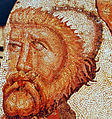
Back Villa Romana de La Olmeda German Villa romana La Olmeda Spanish Villa romaine de La Olmeda French Villa romana di La Olmeda Italian

The palatial Late Antique Roman villa at La Olmeda is situated in Pedrosa de la Vega in the province of Palencia (Castile and León, Spain), near the banks of the Carrión.[1] Long known as the provenance of chance finds, it was finally professionally excavated from 1968, and was declared a Bien de Interés Cultural, 3 April 1996.[2]
The site was donated in 1984 to the Diputación de Palencia by its proprietor and discoverer, Javier Cortes Álvarez de Miranda, who had supported the archaeological investigation of the site from 1969 to 1980. It is open to the public, while a museum dedicated to the finds is housed in the nearby church of San Pedro de Saldaña.
The agrarian villa was developed in several stages, from the first to the third century AD, with major reconstruction in the fourth century and extending in use at least to the end of the fifth.[3][4] The villa complex centers on the elite quarters of rigorously symmetrical disposition, wherein twenty-seven rooms, twelve with mosaic floors, are disposed around a central patio crossed with mosaic paths in geometric patterns and linked round its perimeter by a wide peristyle. This main building housed the poentior,[definition needed] with its oecus or reception hall, centered in the east wing featuring a particularly resplendent mosaic floor. Slightly raised semicircular apses mark its northeastern and northwestern end rooms. The main body of the villa communicated with a baths by a grand passageway. The principal front of the main block faces south, with a porticoed gallery ending in octagonal tower blocks. The residential quarters face north with two rectangular corner towers.
The complex also included working and living quarters of more rustic aspect, kilns for baking roof tiles on the site, three burial grounds, and a section of paved roadway.[5]
-
The protective housing, designed by Ángela García de Paredes and Ignacio García-Pedrosa
-
Storing area at Roman villae of La Olmeda
-
Thermae at La Olmeda
-
The hunt mosaic from La Olmeda
-
Mosaic depicting Odysseus
- ^ Pedro de Palol Salellas, La villa romana de La Olmeda de Pedrosa de la Vega (Palencia):Guía de las excavaciones (Palencia: Diputación Provincial), 1982
- ^ Decreto 97/1996, de 3 de abril, por el que se declara Bien de Interés Cultural, con categoría de Zona Arqueológica, el Yacimiento «La Olmeda» en Pedrosa de la Vega (Palencia).
- ^ "Villa Romana de La Olmeda, Palencia". arteespana.com (in Spanish). Retrieved Feb 9, 2019.
- ^ A Visigothic-era cemetery overlies part of the site, covered in turn by a medieval one.
- ^ A.Álvarez, J. Antonio, "La villa romana de ;La Olmeda' y su museo monográfico"



